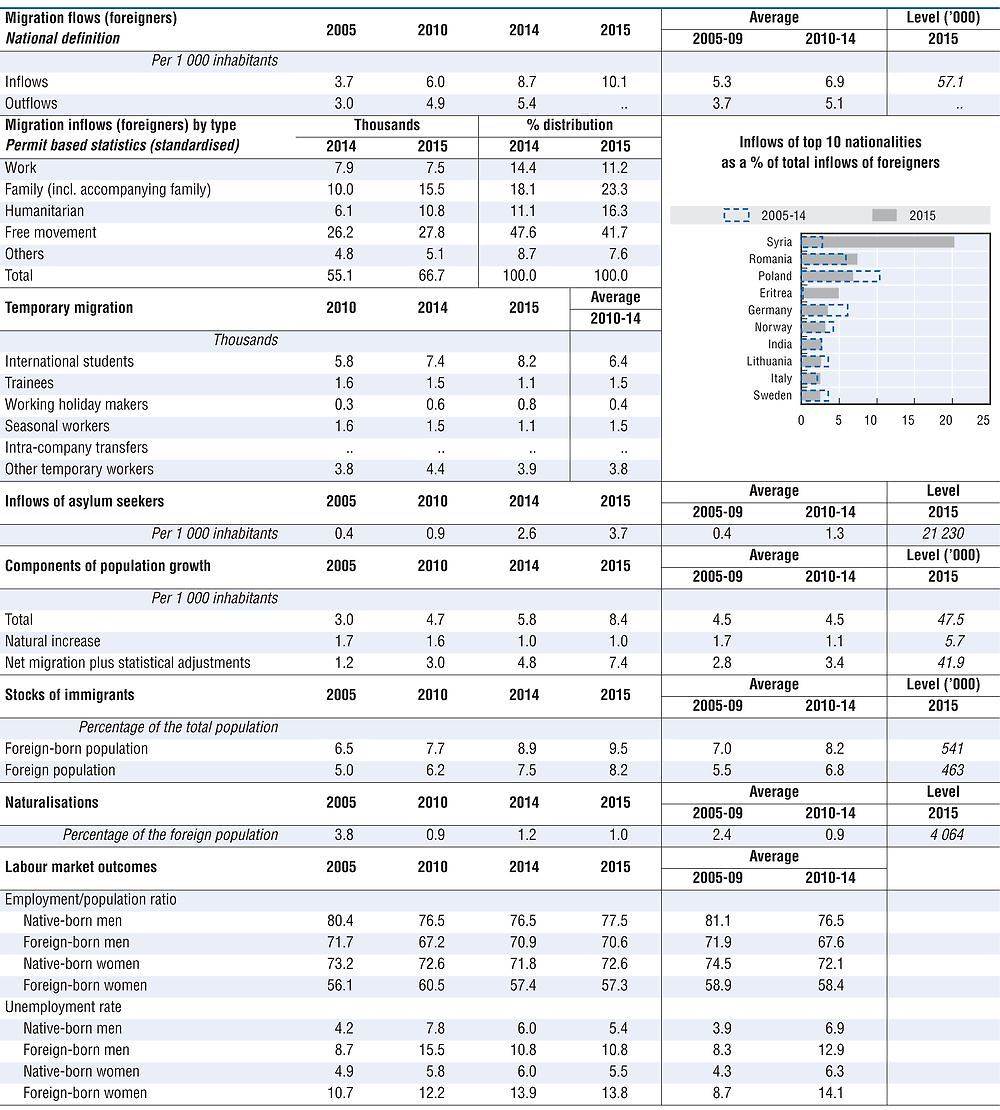Denmark
The number of immigrants in Denmark (defined as a person who is born abroad, with parents who are neither Danish citizens nor born in Denmark) increased by 6% in 2016. On 1 January 2017, they were 570 000, exactly 10% of the total population. Immigrants of Polish origin are the largest group (39 000), followed by those coming from Syria (34 000) – Syrian immigrants were only the 14th largest group at the beginning of 2015 – and from Turkey (33 000).
In 2016, immigration to Denmark decreased for the first time since 2009 but remained at relatively high levels. According to Statistics Denmark, 73 000 foreign nationals moved to Denmark in 2016, a -5% drop from 77 000 in 2015. Net migration of foreigners remained positive but fell to 33 000 persons and that of Danish citizens was under +1 000. Syria was still the main origin country in 2016, followed by Romania and Poland, but the sharp decrease in the number of entries of Syrian citizens (-3 000) accounts for most of this decline in migration flows to Denmark. Inflows of Eritreans have also diminished (-2 000). Entries of EU nationals are stable (21 000) but their share remains under 30%, which was not seen before 2015.
After very sharp increases between 2012 and 2015 the number of residence permits granted fell by -5% in 2016, to 80 000. Again, this overall figure is higher than in any year prior to 2015. As in 2015, 37 000 of these permits went to EU/EEA citizens. The number of new permits delivered to students (including au pairs and trainees) and to workers both increased by more than 10%, to 14 300 and 12 900, respectively. Permit grants for the purpose of family reunification (8 100) and on humanitarian grounds (7 500) both dropped by a third, driving the overall decline. Among recipients of family and humanitarian permits, Syrian nationals were the largest group, while most work permits were delivered to Indians, study permits to US citizens, and 80% of au pairs come from the Philippines.
Denmark received 6 000 new applications for asylum in 2016, a 70% drop from the 2015 figure. Syria was still the main origin country, but applications from Syrian citizens accounted for only 10% in 2016, compared to more than 40% in 2015. More than 7 000 asylum decisions in 2016 had a positive outcome. This represents 68% of the total number of decisions made at first instance, compared with 62% for the EU as a whole.
Danish citizenship was acquired by 15 000 persons in 2016, more than triple the 2015 figure. Iraq, Afghanistan, Somalia and Turkey are the main countries of former nationality. This sharp increase may be partly the result of the amendment of the Nationality Act, which came into force in September 2015 and facilitated the acquisition of Danish citizenship, including by allowing foreign citizens to retain their previous nationality.
Among other recent policy changes, a number of legislative and administrative measures in the field of asylum and migration were introduced at the end of 2015. The changes included limiting the duration of residence permits granted to refugees, postponing the right to family reunification for refugees with temporary protection, tightening the conditions for permanent residence permits, tightening the rules on revoking refugees’ residence permits and reducing economic benefits for asylum seekers. The amendments also included new rules on detention and on suspension of automatic access to judicial review within three days. The suspension of judicial review within three days can only be applied in special circumstances when there are too many newly arrived asylum seekers for the courts to respect the three-day review period. Rules were also introduced, in specific cases, on the seizure of asylum seekers’ assets in order to cover expenses for maintenance etc. during the asylum process.
In January 2016, Denmark reintroduced temporary border controls at the German border, which were extended until February 2017 in accordance with the decision of the Council of the European Union of 12 May 2016 setting out a recommendation for temporary internal border control in those exceptional circumstances which put the overall functioning of the Schengen area at risk.
In February 2016, the Government launched the “United for better integration” proposal and called for negotiations with social partners and municipalities in order to reach agreements on integration. It proposed to amend the integration programme in order to reach better results concerning labour market integration of refugees and immigrants; to intensify the integration programme; and to give Danish courses an even greater focus on labour market integration.
In March 2016, the Government signed two agreements with the social partners (the tripartite agreement) and Local Government Denmark (as the representative for the 98 municipalities) as a follow-up on the Government proposal from February. The agreements aim at improving the framework for labour market integration in particular and contain more than 80 initiatives. Most of the initiatives in the two agreements have been implemented by amendments to the Integration Act and by a new Act on an Integration Basic Education (IGU), which came into force on 1 July 2016.

